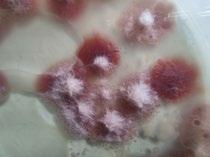Distribution of fusarial toxins
Fusarial toxins can be found in food, feed, freshly harvested and stored agricultural commodities worldwide.
Zearalenone
Zearalenone is produced by F. culmorum, F.cerealis, F. semitectum, F. equiseti and F.graminearum (Krol et al., 2018).

They are highly associated with corn and corn-based products, but also can be found in paddy, sorghum, pearl millet, wheat, beans, curry, barley, asparagus, chilli pickle, cowpea, triticale, soybeans, red wine, beer, onion, garlic, black radish, black tea, coffee, grapes, cassava products, figs, peanuts, milk, meat, egg, leaves of orange, dietary plants, mint, sage leaves, medicinal plants, brewing adjuncts, valerian root, linden flowers and chamomile in China, Tanzania, Ivoire, Italy, South Africa, Portugal, India, Turkey and Spain (Ma et al., 2018) (Table 1).
3
Fusarium species Mycotoxins
F. verticillioides FB1, FB2, FB3
F. acuminatum T-2, MON, HT-2, DAS, MAS, NEO, BEA
F. anthophilum FB1, FB2, BEA
F. avenaceum MON, BEA
F. cerealis NIV, FUS, ZEN, ZOH
F. chlamydosporum MON
F. culmorum DON, ZEN, NIV, FUS, ZOH, AcDON
F. equiseti ZEN, ZOH, MAS, DAS, NIV, DAcNIV, FUS, FUC, BEA
F. graminearum DON, ZEN, NIV, FUS, AcDON, DAcDON, DAcNIV
F. heterosporum ZEN, ZOH
F. nygamai FB1, FB2, BEA
F. oxysporum MON, BEA
F. poae DAS, NIV, FUS, MAS, T-2, HT-2, NEO, BEA
F. proliferatum FB1, BEA, MON, FUP, FB2
F. sambucinum DAS, T-2, NEO, ZEN, MAS, BEA
F. semitectum ZEN, BEA
F. sporotrichioides T-2, HT-2, NEO, MAS, DAS
F. subglutinans BEA, MON, FUP
F. tricinctum MON, BEA
Mechanisms of action and degradation of fusarial toxins
Fumonisins
Fumonisins inhibit the function of the key enzyme ceramide synthase, interrupting the completion of sphingolipid metabolism in cells, hepatocytes, tissues, renal cells, and neurons.
Biosynthesis of sphingolipids occurs in the endoplasmic reticulum through a process of hydrolysis from complex sphingolipids into ceramides and, later, to sphingosine, which is phosphorylated and cleaved to fatty aldehyde and ethanolamine phosphate for further incorporation into phosphatidyl-ethanolamine.

4
Table 1 Fusarium species associated with food and feed and their mycotoxins.
Alteration of sphingolipid biosynthesis can play a crucial role in carcinogenesis and disease development by damaging DNA (Alizadeh et al., 2012) (Figure 1).

Trichothecenes
Fumonisin B1
Inhibits the function of ceramide synthase
Ceramide
Accumulation of free sphinganine causing cytotoxicity

Sphinganine
Trichothecene degradation is mainly based on their epoxide group and acylated side chains (acylated trichothecenes referred to T-2 toxin and non-acylated trichothecene referred to DON).
Degradation of trichothecenes involves two mechanisms:
1. De-acylation occurs in acylated trichothecene degradation (T-2 to HT-2 to T-2 triol).
2. De-epoxidation occurs in non-acylated trichothecene degradation (DON).
Some reports state that oxidation or isomerization, hydroxylation and glycosylation are also pathways involved in trichothecene degradation, forming compounds that can later be regenerated or rehydrolyzed in the digestive tract of humans and animals (Wang et al., 2020).
5 OH OH H3N+
Figure 1. Mechanism of action of Fumonisin B1
Zearalenone
ZEN metabolism involves two degradation mechanisms:
1. Cleaving a lactone ring structure into a less toxic compound (α-zearalanol an The enzyme ZEN lactonohydrolase supports this pathway, resulting in damaging estrogenic activity through decarboxylation (Popiel

2. Another pathway occurs through a lactone intermediate without decarboxylation, without observation of estrogenic activity (Tintelnot et al., 2011).
Effects of fusarial toxins
Fusarial toxins have important toxicological effects in humans and animals.
They have proven to be nephrotoxic, carcinogenic, hepatotoxic, hepatocarcinogenic and cytotoxic in mammalian cells, with estrogenic, immunotoxic, and emetic effects, leading to intestinal, lung, liver, and kidney damage (Yu et al., 2021) (Figure 2).

Furthermore, ingestion of fusarial toxin-contaminated feed is linked to leukoencephalomalacia in horses, and pulmonary edema syndrome and hydrothorax in pigs (Kaminski et al., 2020).

6

TOXIC EFFECTS
Leukoencephalomalacia
Pulmonary edema
Kidney damage
Intestinal destruction
Liver damage
Growth retardation
Carcinogenesis
Reproductive toxicity
Decreased fertility
Neurotoxicity
Hepatotoxicity
Nephrotoxicity
ANIMALS AND HUMANS
CEREALS AND FEED
Fumonisins
FB1 derived sphingolipids display intricate protagonism in many cell function processes.
Accumulation of sphingoid bases causes cell growth inhibition, leading to cytotoxicity and interfering with protein kinase C, Na+/ K+ ATPase, triggering or constraining enzymes involved in lipid signaling pathways and activating phospholipase D, as well as interfering with dephosphorylation of retinoblastoma protein.
This process increases the risk of cancer via lipid mediators and apoptosis that control cell proliferation.
Ceramide synthase inhibition leads to the accumulation of free sphinganine in the kidneys, liver, and lungs
This hydrophobic compound is capable of crossing cell membranes and shows up in urine and blood.
This mechanism targets the kidney and liver in most animals by increasing oncotic necrosis, regeneration, apoptotic, and bile duct hyperplasia (Liu et al., 2019).
Therefore, FB1 is considered a Group 2B carcinogen in humans by the International Agency for Research on Cancer (IARC) since 2002.
Fumonisins are also known to be phytotoxic.
Studies have shown that FB1 is harmful for pigweed, hemp sesbania, and duckweed, causing chlorophyll loss and stunted growth.
7
Figure 2. Toxic effects of fusarial mycotoxins.
FUSARIAL TOXINAS
Zearalenone
ZEN has cytogenetic toxicity, leading to decreased fertility as well as anti-androgenic effects in pigs, cattle, and sheep (Feizollhi et al., 2020).
Trichothecenes
The 12,13-epoxy-trichothec-9-ene nucleus found in trichothecenes is necessary for its toxicity, inhibiting DNA and RNA synthesis, affecting intestinal integrity, and causing immunotoxicity and emetic effects.
Fusarial toxin remediation
Due to the toxicity of fusarial toxins, it is important to implement measures to reduce contamination in food and feed matrixes to decrease the risk of health hazards among humans and animals (Buszewska-Forajta et al., 2020).
International organizations such as the European Food Safety (EFSA), World Health Organization (WHO) and Food and Agriculture Organization (FAO) have set up strict control measures, establishing maximum residue levels in food and feedstuffs, for example:
Total FB1 and FB2: 2000 µg/kg in maize meal
ZEN: 0.25 µg/kg in cereals/ feed
DON: 2000 µg/kg in wheat, barley, and maize
(Schrenk et al., 2020)
In this context, many remediation strategies have been put in place, including physical, chemical, and biological methods (Li et al., 2021).

8
Biodegradation of fusarial toxins
Biological detoxification methods are efficient, specific, and environment-friendly.
Although the microbes used in them have the limiting factor of requiring certain growth conditions, due to their enormous beneficial applications for toxin degradation, biodegradation of fusarial toxins with bio-adsorbents and enzymes is a promising strategy that has attracted the attention of the scientific community (Deepa et al., 2021) (Figure 3).
TRICHOTHECENES AND ZEARALENONE Degradation process
ENZYMES
Esterase, laccase, protease, endo-enzymes, exoenzymes, intracelular enzymes, peptidases
MECHANISMS
De-epoxidation, deacylation, de-carboxylation, glycolysation, reduction, cleavage of lactone ring, adsorption, oxidation

Toxic groups in fumonisins, such as tricarboxylic acid group (-TCA) and amino group (-NH2), inhibit the sphingosine N-acetyltransferase during sphingolipid metabolism, blocking the sphingolipid signaling and affecting cell differentiation, apoptosis, and proliferation.
Fumonisin B1 (FB1)
Hydrolyzed fumonisin B1 (HFB1)
TCA NH2
Reduced toxic products
9
Figure 3. Biodegradation of fusarial toxins.
Fumonisin biodegradation
The FB1-degrading enzyme carboxylesterase can remove the -TCA group, leading to the formation of hydrolyzed fumonisin B1 (HFB1) with less harmful effects than FB1 (Alberts et al., 2019).
It has been shown that the presence of FB1 in intestinal cells inhibits the ceramide synthase enzyme, forming acetylated N-acyl HFB1, which is more toxic than HFB1, reducing body weight and disrupting the gut microbial balance in broilers (Yu et al., 2022).
In a study, a fusion enzyme was designed for the degradation of FB1 using carboxylesterase and aminotransferase. This enzyme was cloned to vector pPIC9K, successfully expressed in the host Pichia pastoris GS115, and named FUMD1
Evaluated in GES-1 cells, it proved to be safe for controlling FB contamination in feed and food(Li et al., 2022).
Saccharomyces cerevisiae strain IS1/1 and SC82 degraded FB1 by 45% and 22%, and a mixture of FB1 and FB2 by 50% and 25%, respectively.

Camilo et al. (2000) applied three strains of Bacillus species (S9, S10, S11) that degraded FB1 by 43%, 48%, and 83%, respectively.
Complete degradation of FB1 was observed 24h after applying the strain NCB 1492 and bacterial consortium SAAS79 (Benedetti et al., 2006).
FumD enzyme completely degraded FB1 to HFB1 in the duodenum and jejunum of pigs in turkeys(Schaumerger et al., 2016).
The black yeast Exophiala spinifera degraded FB1 to AP1 (Polyolamine) and 2-OP1 by extracellular enzyme carboxylesterase. Recently, Azotobacter was shown to be a key bacterium for degradation of FB1, reporting 98% of degradation after a 2-hour incubation (Deepa et al., 2022).
Deepthi et al. (2016) reported FB1 degradation by 61.7% after treating with Lactobacillus plantarum MYS6.
10
ZEN, DON, DAS, and T-2 toxin biodegradation
Some lactic acid bacteria, such as Pseudomonas otitidis (Tan et al., 2015), Rhodococcus pyridinivorans strains K408/ AK37 (Cserhati et al., 2013), and Bacillus velezensis strain ANSB01E (Guo et al., 2019) degrade and detoxify ZEN and T-2 toxin simultaneously (Barlkiene et al., 2018).
Saccharomyces cerevisiae CECT 1891 andL. acidophilus 24 act as an adsorbent, degrading ZEN, DON, and FB1 (Campaginolloo et al., 2015).
Ery4 laccase enzyme from Pleurotus eryngii degrades multiple mycotoxins, including FB1, ZEN and T-2 toxin (Lio et al., 2018).

Microbiota isolated from chicken intestines had the capability to degrade nearly 12 trichothecenes through de-epoxidation and diacylation (Young et al., 2007).
Rat microbiota, through de-epoxidation, transformed T-2 toxin into HT-2 toxin, as well as de-epoxy T-2 triol and DAS to de-epoxyscirpentriol and deepoxymoniacetoxyscirpenol.
Pig gut microbiota degraded ZEN through hydrolysis into α-zearalenol and DON into de-epoxy DON through de-epoxydation mechanism.
However, certain reports suggest that ZEN-derived products are more toxic than the ZEN (zearalenol > α-zearalanol > zearalenone > β-zearalenol) (Krol et al., 2018).
Eggerthella species DII-9 degrade up to 86% trichothecenes (DON, T2 triol, HT-2, T-2 tetraol) through de-epoxidation (Gao et al., 2018).
Bacillus pumilus ES-21 degraded ZEN more than 95.7% with release of degraded product 1-(3,5-dihydroxyphenyl)-60hydroxy-l0-undecen-l00-one through esterase activity (Wang et al., 2017).
Bacillus amyloliquifaciens degraded ZEN through extracellular enzymes without any derivatives (Xu et al., 2016).
Nine biocontrol agents from Aspergillus andy Rhizopus detoxified ZEN, resulting in five degraded compounds α- zearalenol-sulfate, ZEN- O-16glucoside, α-zearalenol, ZEN-14-sulfate and ZEN-O-14 (Koch et al., 2014)

Bifidobacterium and Lactococcus lactis isolated from milk neutralized ZEN by absorption process up to 88% (Mokoena et al., 2005).

 N. Deepa and M.Y. Sreenivasa
Molecular mycotoxicology Laboratory, Department of Studies in Microbiology, University of Mysore, Manasagangotri, Mysore, Karnataka, India.
N. Deepa and M.Y. Sreenivasa
Molecular mycotoxicology Laboratory, Department of Studies in Microbiology, University of Mysore, Manasagangotri, Mysore, Karnataka, India.
















